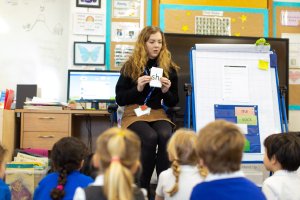Phonics

At Staverton, we use Read, Write Inc systematic, synthetic phonics to teach our phonics. In EYFS, Year 1 and into Year 2, daily reading sessions are based around Read, Write Inc programme. This promotes pupils’ phonics knowledge and decoding at word level, developing reading fluency, and using the alphabetic code to encode for spelling. Children engage in reading a variety of Read, Write Inc phonic books matched to the progression on a one to one basis. Comprehension and reading for pleasure are developed through reading a whole class book on a daily basis.
In Read Write Inc. Phonics pupils:
- Decode letter-sound correspondences quickly and effortlessly, using their phonic knowledge and skills
- Read common exception words on sight
- Understand what they read
- Read aloud with fluency and expression
- Write confidently, with a strong focus on vocabulary and grammar
- Spell quickly and easily by segmenting the sounds in words
- Acquire good handwriting.
Our aim is for pupils to complete the phonics programme as quickly as possible. The sooner they complete it, the sooner they will be able to choose books to read at their own interest and comprehension level.
Once children complete the Read Write Inc. Phonics programme they are taught reading through whole class guided reading sessions. As part of guided reading, children are taught spelling using the Read Write Inc. Spelling programme.
Targeted academic support
We use Read, Write Inc to regularly assess children’s progress in phonics. Sometimes it is necessary to provide extra support for our children with word reading. For this, we use 1:1 tutoring to ensure all children are able to read fluently using recall of their phonic knowledge. Teachers ensure that children at risk of underachievement have daily one to one reading which is carefully tracked.